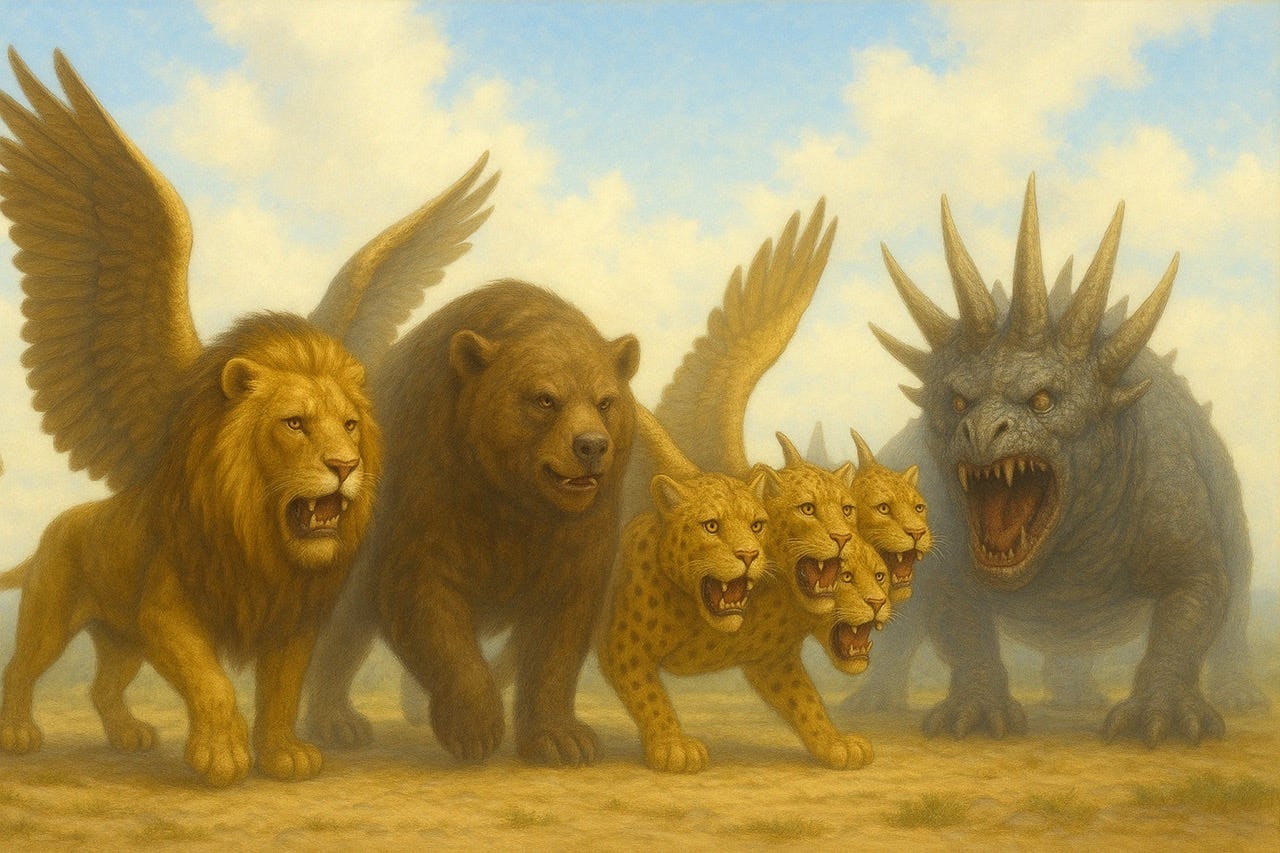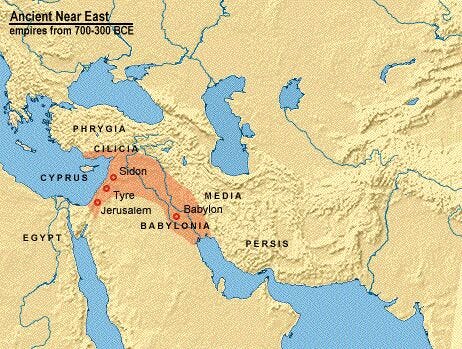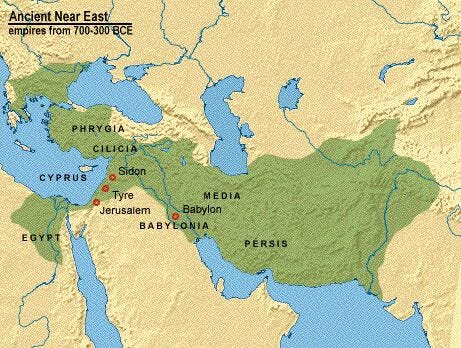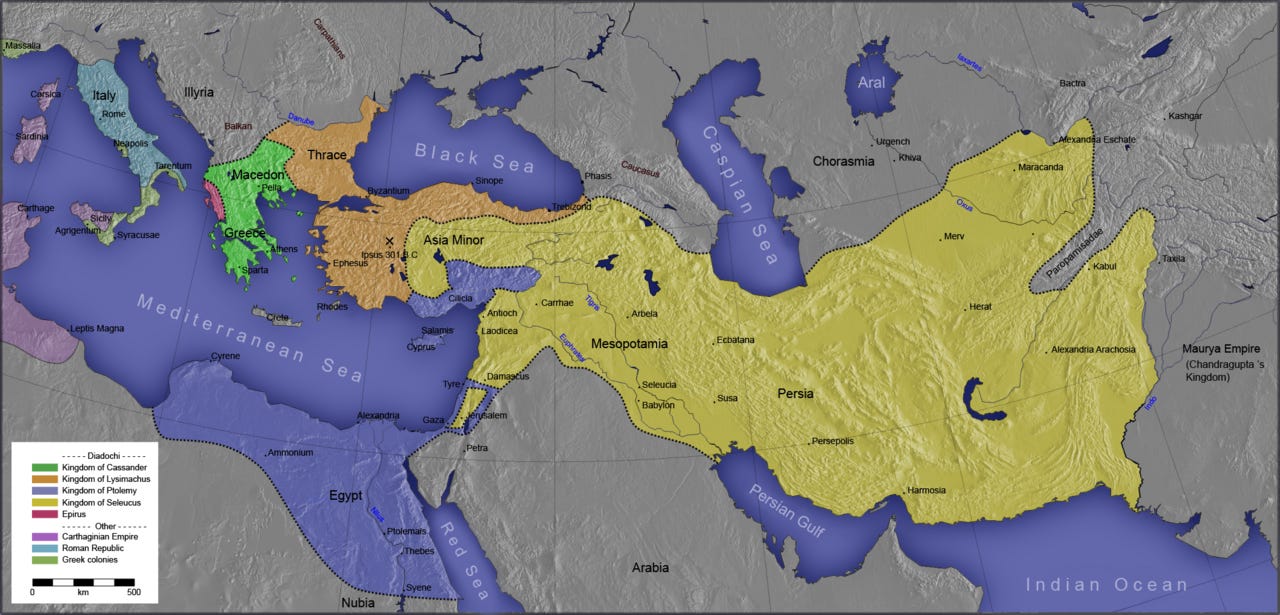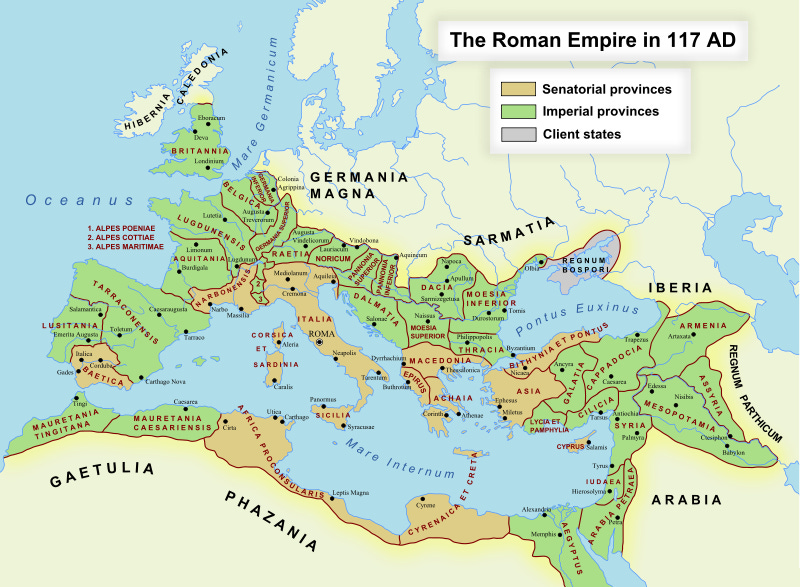Diving into Daniel: A Strange Vision
Daniel 7:1-8 - Analyzing Biblical prophecy is a way to grow in spiritual understanding and belief, even if some things don’t make sense (yet).
“In the first year of Belshazzar king of Babylon Daniel saw a dream and visions in his mind as he lay on his bed; then he wrote the dream down and related the following summary of it. Daniel said, “I was looking in my vision by night, and behold, the four winds of heaven were stirring up the great sea. And four great beasts were coming up from the sea, different from one another. The first was like a lion and had the wings of an eagle. I kept looking until its wings were plucked, and it was lifted up from the ground and made to stand on two feet like a man; a human mind also was given to it. And behold, another beast, a second one, resembling a bear. And it was raised up on one side, and three ribs were in its mouth between its teeth; and thus they said to it, ‘Arise, devour much meat!’ After this I kept looking, and behold, another one, like a leopard, which had on its back four wings of a bird; the beast also had four heads, and dominion was given to it. After this I kept looking in the night visions, and behold, a fourth beast, dreadful and terrifying and extremely strong; and it had large iron teeth. It devoured and crushed and trampled down the remainder with its feet; and it was different from all the beasts that were before it, and it had ten horns. While I was contemplating the horns, behold, another horn, a little one, came up among them, and three of the first horns were pulled out by the roots before it; and behold, this horn possessed eyes like the eyes of a man and a mouth uttering great boasts.”
Daniel 7:1-8 NASB1995
Here we go! The first 6 chapters of Daniel are frequently taught and are well-known to believers and document historical events while Daniel is in exile. Chapters 7 through 12 are less popular and not taught very often because they are challenging to the best Biblical scholars (and as a reminder I’m a rank amateur who is learning along with my readers). So now I’m plunging into the first chapter of the apocalyptic prophecies beginning in Chapter 7. I looked at commentary and it is all over the map, although most commentators agree that this chapter mirrors the statue vision that King Nebuchadnezzar had in Daniel 2; that vision was from a human perspective of power and might, while this vision has been described as the way the world systems were seen by God. The vision that Daniel has is about the four Gentile kingdoms: Babylon, Medo-Persia, Greece and Rome. This is explained in further detail later in Daniel 7.
The AI image above isn’t bad, as it attempts to show the four beasts as described in the first part of Daniel 7. The first creature, the winged lion on the left, is before it is lifted up and its wings were plucked and made to stand on its own two feet. The second beast, the bear-like creature is missing the ribs in its mouth, but the AI tool that Steve uses refused to spit out that little detail and keep the other details intact. The third creature is missing a couple of wings but the leopard-like beast with four heads is pretty convincing. Finally, the fourth beast is intimidating, but I’m not sure that the 10 horns came out quite right and the teeth don’t look like they’re made of iron. The little horn is not present at all. These AI resources are probably completely confused about the descriptions from the Bible but I’m amazed at how they try to comply.
This vision comes to Daniel during the first year of Belshazzar, the same king who saw the handwriting on the wall. Scholars estimate this timeframe to be about 553 BC, about fourteen years before the fateful party of Belshazzar. This would coincide with the timeline of events after Daniel 4 but before Daniel 5. So in looking at commentary, I think that Enduring Word has done an excellent job on the book of Daniel. I will supplement their commentary with information from Precept Austin.
Let’s start with the first beast that arises from the sea (assumed to be the Mediterranean). This is the Lion with Eagle wings. Enduring Word has this to say:
a. The first was like a lion: The first beast was more majestic than any of the following beasts (lions and eagles are “kings” of their realms). But this majestic beast was humbled (wings were plucked off) and made human (a man’s heart was given to it).
i. A little later (Daniel 7:17) Daniel tells us that these four beasts are four kingdoms ruling over the earth. The first kingdom is the Babylonian Empire, represented by a lion and an eagle. This fits in well with the majesty and authority of Nebuchadnezzar in his reign over the empire of Babylon.
ii. Jeremiah used both the lion and the eagle as pictures of Nebuchadnezzar (Jeremiah 49:19-22), and Babylon’s winged lions can be seen at the British Museum today.
The Babylonian Empire is shown in the following map, taken from Precept Austin:
The second beast, the bear is described by Enduring Word in this commentary:
b. A second, like a bear: The second beast didn’t have the majestic bearing of either the lion or the eagle. A bear is slower, stronger, and more crushing than a lion – and this bear had a voracious appetite for conquest (Arise, devour much flesh!).
i. The bear represented the Medo-Persian Empire, succeeding the Babylonian Empire. In this partnership between the Medes and the Persians, the Persians dominated the relationship. Most think the three ribs represent their three great military conquests: Babylon, Egypt and Lydia.
ii. The slow, crushing armies of the Medo-Persian Empire were well known. They simply overwhelmed their opponents with superior size and strength. “The Medes and Persians are compared to a bear on account of their cruelty and thirst after blood, a bear being a most voracious and cruel animal.” (Adam Clarke)
iii. Arise, devour much flesh: “The command to arise and devour much flesh indicates the extreme cruelties often practiced by the Persians, and the wide extent of their conquests.” (H.A. Ironside)
iv. Liberal commentators have a vested interest in identifying the bear with only the Median state, and not the combined Medo-Persian Empire. They assign the third beast to the Persian Empire, and the fourth to Alexander’s Greek Empire, so as to remove (even for a second century author) any element of predictive prophecy. Their analysis doesn’t fit. There are many good reasons why the second kingdom could not be exclusively the Median kingdom.
· The Median kingdom did not follow the Babylonian in historical sequence, but was contemporary with it, even rising to strength before the Neo-Babylonian period.
· The Median kingdom never had a world position ranking with the Persian, Grecian or Babylonian Empires.
· The motivation for the interpretation is solely to remove any reference to Rome – and to divinely predictive prophecy.
Here is a map of the Medo-Persian Empire, demonstrating the voraciousness of conquest for that Gentile empire (from Precept Austin):
The third beast, the winged/four-headed leopard creature is described in this commentary from Enduring Word:
c. Another, like a leopard: The leopard was known for its sudden, unexpected attacks. This one was especially swift (with four wings), and clever (having four heads).
i. Each animal is mighty, but dominates its prey in a different way. “The lion devours, the bear crushes, and the leopard springs upon its prey.” (Lehman Strauss)
ii. The leopard represented the Greek Empire. Alexander the Great quickly conquered the civilized world by age 28. “Nothing in the history of the world, was equal to the conquests of Alexander, who ran through all the countries from Illycrium and the Adriatic Sea to the Indian Ocean and the River Ganges; and in twelve years subdued part of Europe, and all Asia.” (Adam Clarke)
iii. After his death his empire was divided into four parts (four heads). Specifically, the four heads were Casander, Lysimachus, Seleucus, and Ptolemy, who inherited Alexander’s domain after his death.
iv. The Babylonian Empire dominated in Daniel’s day. One might have guessed – especially in the reign of Belshazzar – that the next empire would be the Medo-Persian Empire. But how could Daniel know that the next world empire would be like a leopard in its rise and prominence, and that it would be divided into four parts? This shows a plain principle: God knows the future, and reveals certain details of the future through His prophets. It shows that God lives outside our time domain and can see the future as well as the past. He sees the whole parade of human history, not just the part passing in front of a single spectator. The proof of fulfilled prophecy is exceptionally persuasive; no wonder Peter says: We have the prophetic word confirmed, which you do well to heed as a light that shines in a dark place, until the day dawns and the morning star rises in your hearts (2 Peter 1:19).
God does indeed know the future! Here is the map of the Greek Empire that was found on Precept Austin; the four subdivisions of the empire after the death of Alexander are noted in the different colors.
Finally, the dreadful and terrifying fourth beast with ten horns is the Roman Empire. Here is the commentary from Enduring Word
a. A fourth beast, dreadful and terrible: The fourth beast was indescribable, and uniquely horrific in its power and conquest.
b. Different… it had ten horns: In the ancient world horns expressed the power and fearsomeness of an animal. This fourth beast was so strong it had ten horns.
i. Different people picture this in different ways. Some suggest that the ten horns were actually two five-pointed antlers, rather than ten separate horns.
ii. In historical fulfillment, the fourth beast represents the Roman Empire, which was the largest, strongest, most unified and enduring of them all.
iii. “There is an unmistakable correspondence between these horns and the ten toes of the dream image (ch. 2), and the mention of iron in the teeth suggests the legs and toes of iron in that image.” (Gleason Archer)
c. Another horn, a little one… a mouth speaking pompous words: Among the ten horns, three are replaced by one horn that was conspicuous for its dominance (before whom three of the first horns were plucked out by the roots), intelligence (eyes like the eyes of a man), and its boastful talk (speaking pompous words).
Here is a map of the Roman Empire at its peak, from Precept Austin:
I’ll be honest with you, dear readers: The part of the vision about the conspicuous horn (the small horn that supplants three horns and has eyes and a boastful manner) on the fourth beast is something I don’t comprehend in any way at this early point in this analysis. This nuance is explained in greater detail later in Daniel 7, so I will defer that until I get to those verses.
So I think this covers the first eight verses pretty well and most of it makes sense to me. My next devotional examines Daniel 7:9-12 - The Ancient of Days reigns.
Heaven on Wheels Daily Prayer:
Dear Lord - Please guide me into understanding as I dive into the prophecies of Daniel. Amen.
Scripture quotations taken from the (NASB®) New American Standard Bible®, Copyright © 1960, 1971, 1977, 1995 by The Lockman Foundation. Used by permission. All rights reserved. lockman.org
Enduring Word commentary by David Guzik is used with written permission.
Precept Austin was accessed on 4/20/2025 to review commentary for Daniel 7:1-8.



